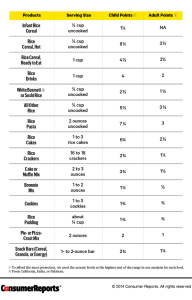Arsenic and Rice: Why Rice Cereal For Babies Is Not A Good Choice.
Posted on | November 19, 2014 | Comments Off on Arsenic and Rice: Why Rice Cereal For Babies Is Not A Good Choice.
Mike Magee
Thanks to Consumer Reports, most Americans are at least somewhat aware that there are issues with rice – specifically arsenic. Their initial report from 2012 has just been updated with a 2014 Report with hundreds of measurements and testing of alternate grains as well. What do you need to know?
The Basics:
Arsenic is a naturally occurring toxic metallic element found in soil and water. In large enough concentrations in its’ inorganic form, it’s a proven carcinogenic substance. Arsenic concentrates differently in varied plants. One of the foods that concentrates arsenic at the highest levels is rice. The use of “arsenic-based pesticides, drugs and rice byproducts in agricultural production” has artificially elevated the concentration of arsenic in food and water in parts of the U.S. This, in turn, has continued to elevate arsenic levels in rice plants from some areas of our country. Brown rice, which naturally retains the grains outer sheath covering and has nutritional advantages compared to white rice, is higher in arsenic than white rice which has had the sheath removed. This is because the outer coverings of rice absorb arsenic at the highest levels. Rice is not only a popular food for adults in America but also extensively used in processed baby cereals, crackers and rice cakes, and as a milk alternative in childhood beverages. Babies and young children are especially vulnerable to arsenic.
The Findings/Recommendations:
1. “Children (up to 70 pounds) should rarely eat hot rice cereals or rice pastas. Those products all had some of the highest measured levels of total inorganic arsenic.” According to Consumer Reports: “The FDA should immediately address the risk for children consuming rice and commonly consumed rice-based foods, including rice cereals, pastas, and beverages, by setting standards for inorganic arsenic in those food.”
2. “Rice labeled as from the U.S. or from Arkansas, Louisiana, or Texas …has the highest levels of total inorganic arsenic compared with rice from elsewhere.” This contrasts with rice from California which generally has much lower levels of arsenic.
3. Brown rice has higher levels than white rice, but also some nutritional advantages. Specifically, brown Basmati rice from California, India and Pakistan, and sushi rice from the U.S. had the lowest levels of arsenic of all varieties tested. Amaranth, millet, and quinoa are also safer alternatives.
In lieu of FDA action, Consumer Reports has created a point system to help guide consumer choice and behavior. Each product was assigned a number of points with differentiation of children and adults. Over a course of one week, CR recommends that neither child nor adult exceed 7 points.
The Full Report is available HERE.
For Health Commentary, I’m Mike Magee.




